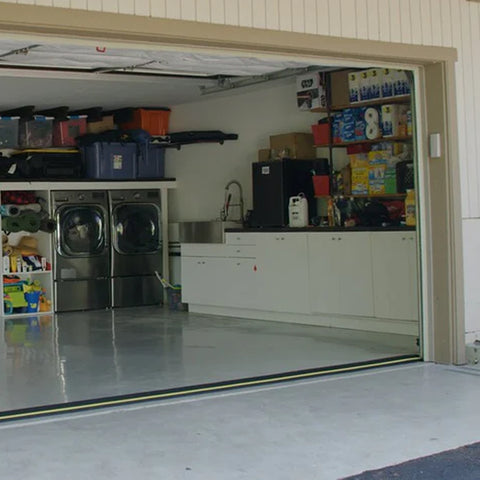Why Are The Walls Of My Garage Wet? Understanding and Preventing Wet Garage Walls
Discovering water on your garage walls that refuses to dry up can be concerning. Identifying the source of the water is crucial to addressing the issue effectively and preventing further damage. In this guide, we'll explore common reasons for wet garage walls and provide practical solutions to keep your garage dry and protected.
Identifying the Source of Water:
Understanding why water is present on your garage walls is the first step in solving the problem. Here are some common causes:
- Leaking Roof: Flaws or damage to your garage roof can allow water to seep in after heavy rainfall or snowfall.
- Compromised Seals: Damaged seals around windows, doors, utility seams, or between the wall and floor can lead to water infiltration.
- Garage Door Gaps: Gaps around the garage door, if left unattended, can allow moisture and draughts to enter, leading to condensation. Sealing the bottom, sides, and top of your garage door can help prevent this.
Why Is There Water On My Garage Walls?
There are a fair few reasons why you might be finding water running down or pooling in your garage walls, including the most common:
A Leaking Roof
If there are any flaws in your roofing material or any damage to your garage roof, this could act as the perfect site of entry for water after a heavy shower or snowfall.
Compromised Seals
Whether it’s around windows, doors, utility seams, or between the wall and floor, if a seal is damaged or has come away, it’ll no longer be able to prevent water from flowing in.
A garage door, such as a domestic up-and-over door, will have gaps around it. These gaps, if left unattended, can allow moisture and draughts to enter the garage creating condensation.
Sealing the bottom, sides, and top of your garage door can help to prevent this. GaraDry® have designed and developed a range of garage door seals for exactly this purpose.

Cracks and Crevices
This could be due to damaged concrete, broken windows, a faulty garage door, a damaged roof, warped wood… there’s a whole host of reasons why cracks and crevices appear suddenly or over time. If these aren’t repaired, they provide sites of entry for water straight into your garage.
- Addressing Cracks: Promptly repair any cracks or damage to prevent water from entering your garage.
Condensation and Humidity
Another form of pesky moisture which can lead to wet garage walls is condensation and humidity inside the space, often due to poor insulation or concrete walls.
Poor insulation or concrete walls can lead to condensation and humidity inside the garage, contributing to wet walls.
- Insulation Consideration: Insulating the garage and garage door can help control condensation and humidity levels. Explore products like GaraDry's DIY garage door insulation kit for effective insulation solutions.

Testing for Condensation or Humidity:
A simple test with tin foil can help determine if the issue is condensation or humidity-related. Place a piece of tin foil on the damp garage wall and observe the results after a few days.
Additional Factors Contributing to Wet Garage Walls:
- Clogged Gutters: Ensure that gutters are clear of debris to prevent blockages that can lead to water overflow.
- Driveway Slope: Check if the driveway slopes towards the garage door, directing water towards the garage.
- Expansion Gaps: Fill expansion gaps between slabs to prevent water accumulation.
Preventing Wet Garage Walls:
Addressing water on garage walls promptly is crucial to prevent mold, moisture-related health issues, and damage to belongings. Here are some preventive measures:
- Install a Weather Seal: Apply weather seals to the garage door to prevent water infiltration.
- Clear Drains Regularly: Keep drains clear of debris to ensure proper water drainage.
- Repair Damage: Promptly repair any cracks or damage to the garage structure.
- Consider Waterproofing Measures: Apply concrete sealant, waterproof paint, or tanking slurry as additional protective measures.
You May Also Like: How to use tanking slurry to waterproof a garage
As the old adage goes, prevention is always way better than cure, so rather than having to find a way to remedy a damp and mouldy garage further down the line, it’s always a good idea to put some damage control measures in place ahead of time.
Conclusion:
If you’re reading this article because the walls of your garage are already wet, we appreciate prevention isn’t the answer you’re looking for right now. But for those who haven’t yet fallen victim to a soggy garage, take heed of our advice to stay warm, dry and free of mould.
For those who are dealing with damp garage walls, we hope this advice has been helpful to you.
Preventing wet garage walls is essential to maintain a safe, dry, and mold-free environment. By understanding the causes of water infiltration and implementing preventive measures, you can safeguard your garage and belongings from moisture-related damage.
Additional Information and Support:
- For simple solutions to garage door gaps at the base of your garage, please see our range of Garage Door Seal Kits.
- For sealing the top or side of your garage door, please see our range of Garage door Top and Side Seals
- If you also need to insulate your Garage, please see our Garage Door Insulation kit
If you require additional help on any of our products or you require advice on sealing your Garage, please contact us and we will be happy to help.


